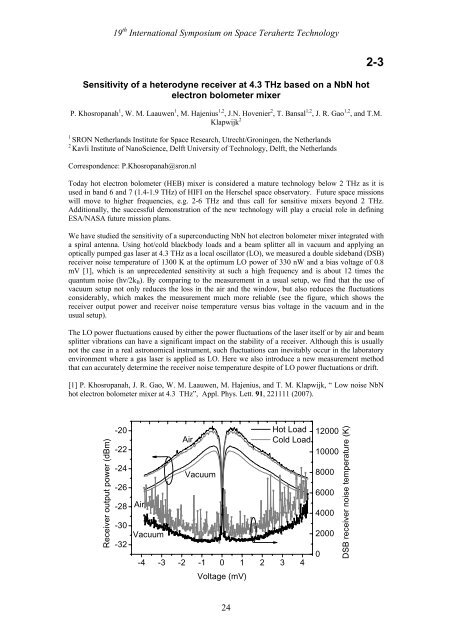Program and Abstract Book - SRON
Program and Abstract Book - SRON
Program and Abstract Book - SRON
You also want an ePaper? Increase the reach of your titles
YUMPU automatically turns print PDFs into web optimized ePapers that Google loves.
19 th International Symposium on Space Terahertz Technology<br />
Sensitivity of a heterodyne receiver at 4.3 THz based on a NbN hot<br />
electron bolometer mixer<br />
2-3<br />
P. Khosropanah 1 , W. M. Laauwen 1 , M. Hajenius 1,2 , J.N. Hovenier 2 , T. Bansal 1,2 , J. R. Gao 1,2 , <strong>and</strong> T.M.<br />
Klapwijk 2<br />
1<br />
<strong>SRON</strong> Netherl<strong>and</strong>s Institute for Space Research, Utrecht/Groningen, the Netherl<strong>and</strong>s<br />
2<br />
Kavli Institute of NanoScience, Delft University of Technology, Delft, the Netherl<strong>and</strong>s<br />
Correspondence: P.Khosropanah@sron.nl<br />
Today hot electron bolometer (HEB) mixer is considered a mature technology below 2 THz as it is<br />
used in b<strong>and</strong> 6 <strong>and</strong> 7 (1.4-1.9 THz) of HIFI on the Herschel space observatory. Future space missions<br />
will move to higher frequencies, e.g. 2-6 THz <strong>and</strong> thus call for sensitive mixers beyond 2 THz.<br />
Additionally, the successful demonstration of the new technology will play a crucial role in defining<br />
ESA/NASA future mission plans.<br />
We have studied the sensitivity of a superconducting NbN hot electron bolometer mixer integrated with<br />
a spiral antenna. Using hot/cold blackbody loads <strong>and</strong> a beam splitter all in vacuum <strong>and</strong> applying an<br />
optically pumped gas laser at 4.3 THz as a local oscillator (LO), we measured a double sideb<strong>and</strong> (DSB)<br />
receiver noise temperature of 1300 K at the optimum LO power of 330 nW <strong>and</strong> a bias voltage of 0.8<br />
mV [1], which is an unprecedented sensitivity at such a high frequency <strong>and</strong> is about 12 times the<br />
quantum noise (hν/2k B ). By comparing to the measurement in a usual setup, we find that the use of<br />
vacuum setup not only reduces the loss in the air <strong>and</strong> the window, but also reduces the fluctuations<br />
considerably, which makes the measurement much more reliable (see the figure, which shows the<br />
receiver output power <strong>and</strong> receiver noise temperature versus bias voltage in the vacuum <strong>and</strong> in the<br />
usual setup).<br />
The LO power fluctuations caused by either the power fluctuations of the laser itself or by air <strong>and</strong> beam<br />
splitter vibrations can have a significant impact on the stability of a receiver. Although this is usually<br />
not the case in a real astronomical instrument, such fluctuations can inevitably occur in the laboratory<br />
environment where a gas laser is applied as LO. Here we also introduce a new measurement method<br />
that can accurately determine the receiver noise temperature despite of LO power fluctuations or drift.<br />
[1] P. Khosropanah, J. R. Gao, W. M. Laauwen, M. Hajenius, <strong>and</strong> T. M. Klapwijk, “ Low noise NbN<br />
hot electron bolometer mixer at 4.3 THz”, Appl. Phys. Lett. 91, 221111 (2007).<br />
Receiver output power (dBm)<br />
-20<br />
-22<br />
-24<br />
-26<br />
-28<br />
-30<br />
-32<br />
Air<br />
Vacuum<br />
Air<br />
Vacuum<br />
Hot Load<br />
Cold Load<br />
-4 -3 -2 -1 0 1 2 3 4<br />
Voltage (mV)<br />
12000<br />
10000<br />
8000<br />
6000<br />
4000<br />
2000<br />
0<br />
DSB receiver noise temperature (K)<br />
24
















